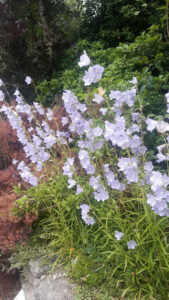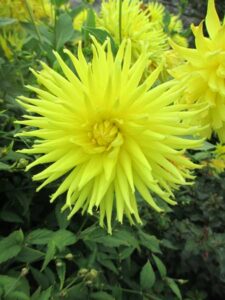WELCOME SPRING!
Welcome spring! Oh yes, television weather experts will tell us that climatically, March 1st is the correct date, but for generations it has been La Feile Brid, and I see no reason to think otherwise. Whether or which, each seasonal change is to be welcomed, for individually they have a unique role to play in the dance of transformation. Spring is the season of rebirth, when life that was seemingly dead in winter, suddenly wakes up, stretches, and comes to life. May this year’s springtime resurrection not alone fill our spirit with energy, enthusiasm, and new life, but heal the brokenness and problems of our unique world.
It/s going to take a little time to improve of course for the sun moves slowly and imperceptibly in the heavens. But it does get that little bit higher day by day, warming the soil so that the hedgerows stir into new fresh greenery. For the past three months (it feels much longer) we have been confined indoors by rain and wind, frost, biting cold, and darkness. Darkness at four in the afternoon is alien to me and unnatural to most of us. Clearly, it is the cause of much depression. Hopefully, there will be more illumination soon, and less darkness as the month progresses.
Since late autumn, we have been slow to venture outside to see how new arrivals (and old friends) were performing, but now, their numbers are increasing. Top of the February list is the reliable and early forms of crocus. Coinciding with the snowdrops, crocus tommasinianus will soon be showing colour but few realise that it is also prolific at self-seeding. A modest patch of six corms can turn into a multiple of hundreds in a very few years. Mature gardens where it has been planted in the past, are now filled with their narrow mauve flowers at every burst of spring sunshine. From this you will gather that they grow ‘like weeds’- but never become a nuisance.
You never see the seeds, which lie hidden at the base of their long tubes, and these are most likely distributed by ants. If you see any potted crocus tommaninianus on sale this month or next, be sure to invest in these cheap, everlasting miracles of spring.
Another joy of late February and on into early March and April are the camellias, arch deceivers no less, for they look almost too exotic to succeed outdoors as easily as they do! They also look as though they should be richly scented, but a blade of grass, an eggshell, has more perfume. Still, no spring garden is complete without at least one variety and even if the ground is totally lime-ridden, these take to pot culture with a willingness that staggers.
A decent sized pot (terra-cotta for preference) filled with a mixture of lime free compost will suit a decent sized camellia for many years. Buy the largest you can afford, bearing in mind that the older you are, the more you need something that won’t take a decade and more to reach a commanding size! ‘Debbie’ is a reliable, free-flowering, vigorous variety which I rate highly. However, if red is not in keeping with your colour scheme then opt for a real treasure named ‘Lavinia Maggi’ in a striking combination of striped white and pink.
WEATHER
Since the solstice, the mornings seem even darker and the dreaded winter weather insists on living up to its reputation. But despite the dreariness, localised flooding, hard frosts, possible snow and biting cold, occasional days of bright sunshine arrive to play unexpected tricks with spectacular light effects. Pale plumes on the ornamental grasses Stipa and Miscanthus light up like fireworks in the low sun whilst long shadows seem to appear everywhere. The box balls throw long shadows across the driveway whilst nearby trees cast thin lines of darkness which, as the light diminishes, pool together and stagnate. I love these winter light effects.
NO DIGGING!
In wet and frosty weather and especially after the rain, hard frosts, and gales of late, the most pressing work is one of tidying up whenever possible but no planting should be undertaken until conditions underfoot thaw fully, dry out appreciably, and become firm. Digging and planting in wet conditions will ruin the soil structure leading to growing problems much later in the season.
THE GARDEN IN FEBRUARY 2023
TRUMPET lilies such as the scented and pure white ‘Regale’ and the lemon on apricot ‘African Queen’ perform well in pots stood outside during summer but after spring repotting needs to be in out of the icy conditions and excess wetness. Mine are in the greenhouse for protection, re-potting and pest inspection. This latter chore is not only sensible but mandatory, for I still suffer the scourge of vine-weevil. At this time of the year it would not be unusual for the white grubs to be found burrowing deep into the fleshy scales of the Asiatic and oriental varieties. After repotting, drench the compost with Provado Vine Weevil Killer.
TULIPS
Writers on border plants carry on as if their favourites will cheerfully last forever. Take it from me, most will not. Many will die off after three or four years, and buying in replacements will certainly be necessary.
It can happen with all bulbs, but tulips in particular. These will slowly die out, obliging you to eventually re-invest in new stock but the odd one will always live on to spoil the artistic harmony that you have created in the garden’s most prominent border. You naturally assume that there will be no survivors from the previous year but you are in for a disappointment as rogue bulbs put in an early appearance. Gardens, I have always maintained, do reserve the right to by being completely idiosyncratic, thwarting as many rules as they obey. Therefore, I am looking forward to another episode of shocking muddles from my tulips old and new during early April. The truly active gardener would of course have removed each rogue when noticed (so as to harmonise all the others) but it is very hard for a plants-man to dig up specimens which have had the grace to live on for more than three years.








